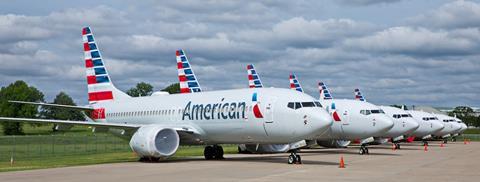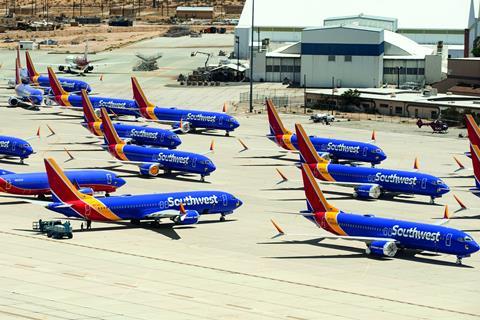The Federal Aviation Administration has cleared the Boeing 737 Max to fly, a move coming 20 months after regulators grounded the jet following two crashes that killed 346 people.
The agency on 18 November rescinded its 13 March 2019 “Emergency Order of Prohibition” – the document barring US airlines from operating Boeing’s latest 737 iteration.
“The design and certification of this aircraft included an unprecedented level of collaborative and independent reviews by aviation authorities around the world. Those regulators have indicated that Boeing’s design changes, together with the changes to crew procedures and training enhancements, will give them the confidence to validate the aircraft as safe to fly in their respective countries and regions,” says the FAA. “Following the return to service, the FAA will continue to work closely with our foreign civil aviation partners to evaluate any potential additional enhancements for the aircraft.”
“The move will allow airlines that are under the FAA’s jurisdiction, including those in the US to take the steps necessary to resume service and Boeing to begin making deliveries,” Boeing adds.
US airlines can now operate the Max again – but only after the jets receive specific modifications, and only by pilots who complete new training related to the narrowbody’s Maneuvering Characteristics Augmentation System (MCAS). Before flying, the jets will also have several other alternations, such as changes to horizontal stabiliser wires to comply with the latest FAA regulations.
The FAA must also approve US Max operators’ pilot training programmes, and the agency has retained authority to issue the airworthiness certificates that clear each specific new 737 Max to fly. Previously, Boeing held that ability.
“Airlines that have parked their Max aircraft must take required maintenance steps to prepare them to fly again,” says the FAA.
“We will never forget the lives lost in the two tragic accidents that led to the decision to suspend operations,” says Boeing chief executive David Calhoun. “These events and the lessons we have learned as a result have reshaped our company and further focused our attention on our core values of safety, quality and integrity.”
With the FAA having acted, attention now turns to other regulators, who must also clear the jet before it can be operated more widely.
Boeing says it had already started making the wire changes to stored Max aircraft. But only now, with the FAA having cleared the jet, will it begin the MCAS-related updates, it says.
How much time will pass before the Max returns to revenue service remains unknown. But American Airlines has scheduled 737 Max flights for the end of December.
Other US airlines with the Max in their fleets include Southwest Airlines and United Airlines.

Globally, airlines have 391 Max in storage, including 86 in US airline fleets, according to Cirium data. Boeing has produced but not delivered another roughly 450 Max, of which it intends to ship about half in 2021. Boeing’s backlog includes 3,365 737s.
”We have more work ahead of us as we begin to again deliver 737s and return the airplane to service worldwide, which will continue to be paced by the timing of other global regulators,” Calhoun says in an 18 November note to Boeing employees.
Resuming deliveries should give Boeing a critical influx of cash, as customers typically pay the majority of a jet’s cost upon receipt, analysts have noted.
In addition to rescinding the grounding order, the FAA on 18 November published an airworthiness directive (AD) laying out required changes to the jets.
It requires various updates, including notable changes to MCAS, the flight-control system that played a central role in the two crashes.
MCAS will now receive input from both the jet’s angle-of-attack (AoA) indicators, and flight-control computers will disable MCAS if the AoAs data disagrees, the AD says.
MCAS activates based partly on AoA data and previously had received input from only one sensor.
Also, MCAS now can activate only once per “sensed high AoA event” – not multiple times, as happened during the accidents when the nose of the each aircraft was repeatedly forced down. In addition, pilots will always be able to override MCAS by pulling back on the control column, says the AD.
The AD also mandates that the jets have cockpit AoA disagree alerts.
Boeing has also updated software to prevent “a theoretical combination of faults that could lead to a runaway stabiliser” – a condition when the trim system makes uncommanded stabiliser adjustments, the company says. Likewise, new software prevents the “remote possibility” of autopilot disengagement.
Additionally, horizontal stabiliser wires must be separated to ensure they meet FAA requirements. And all 737 Max will be checked for foreign object debris, Boeing says.

Additionally, Max pilots must complete new MCAS-specific training and experience MCAS activation in simulators. New training also addresses manual trim issues and “runaway stabiliser” events.
TURNING THE PAGE
The FAA recertification follows an unprecedented and remarkably turbulent chapter in Boeing’s 104-year history. The Max’s troubles began with the crash of Lion Air flight 610 on 29 October 2018, killing 189, and was followed a little under five months later when Ethiopian Airlines flight 302 went down on 10 March 2019 causing the deaths of all 157 on board. Both jets were 737 Max 8s.
Investigators believe the crews were unable to keep their aircraft in the sky after faulty AoA inputs caused MCAS to repeatedly activate.

Boeing gave the Max MCAS to address aerodynamic changes resulting from the jet’s CFM International Leap-1B engines, which are larger than the 737NG’s CFM56 powerplants. The Leaps can make the Max pitch nose-up in certain circumstances.
MCAS counters that tendency by trimming the horizontal stabiliser, pitching the nose down.
From the start, Boeing took heat for not fully disclosing the existence of MCAS to customers, and for a software glitch that made AoA “disagree” alerts inoperable on some jets.
For months, Boeing defended its design, insisting pilots could counter MCAS by following well-defined, long-existing pilot procedures. A malfunctioning MCAS presents like a runaway stabiliser, and pilots can disable the system by following the runaway stabiliser checklist, the argument goes.
The crashes spurred investigations that shook Boeing to its core; documents surfaced that raised troubling questions about the company’s inner workings. Critics accused the airframer of dismissing internal concerns about the Max’s safety, of wrongly denying the need for Max-specific pilot training, of having too much influence over FAA inspectors, and of muscling the Max through FAA certification.
Some analysts have described the Max crisis as the consequence of an internal shift within Boeing following its 1997 merger with McDonnell Douglas. They say Boeing, once driven by engineering prowess, became more obsessed with producing positive quarterly financials and the resulting stock-price gains.
Boeing’s executives, including chief executive David Calhoun, insist the company’s top priority remains safety. Since the crashes, Boeing has created a new internal safety division and shifted its structure so engineers report to the chief engineer, not business unit heads.
The crashes also inspired widespread criticism of the FAA’s certification process – specifically its delegation of huge chunks of certification work to aircraft manufacturers.
Also, air safety experts have said the Max crashes highlight broader concerns about pilot training and maintenance standards – particularly those at some airlines in developing nations.
Pointing to crash reports, those experts and some airline pilots have noted apparent critical missteps by the pilots of the crashed Lion Air and Ethiopian jets.
Story updated on 18 November to include comments from Boeing.


























